01908 6998020845 899 4400 | 01908 699802Tel 01908 699802
Air Fed Welding Masks
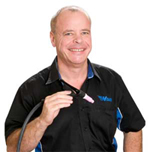

February 2019 saw a “Safety Alert” from the Health & Safety Executive.
The notice reports on new Scientific Evidence that links Welding Fume exposure to Lung Cancer.
Click the “H&S Safety Alert” Text Link below to view, or Downloaded via the “Download” Button:
Welding Fume Protection
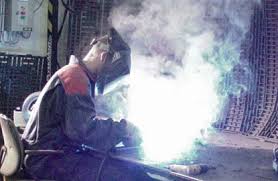
There is no single solution to Welding Fume Protection as it depends heavily on the environment where welding is carried out.
I’ve lost count of number of times a customer has told me that they keep the door open, or they only weld outside as justification for not having proper welding fume protection.
Dealing with Welding Fumes
In simple terms, you have to prevent Welders (and anybody else in the workshop), from breathing in Welding Fumes.
There are two basic ways of doing this: remove the fume at source to prevent it from reaching the welders Breathing Zone. Or protect the Welders Breathing Zone with a Respirator system.
Removing the fume at source means using Fume Extraction Equipment. Protecting the Welders Breathing Zone means using an Air Fed Welding Mask.
Fume Extraction
Fume Extractors come in a number of guises. The three most common are:
- Units with arms that are placed close to the welding
- Benches that suck fumes down into the bench.
- Special Mig Torches that have built in extraction.
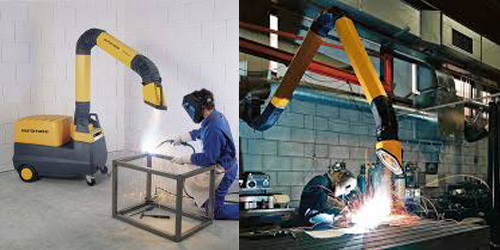
Fume Extractors use air suction to draw the fume away before it can rise into the Welders Breathing Zone.
Fume Extraction systems typically have a filter that filters out the harmful Particulate Fume and returns the cleaned air to the workshop. Some systems extract to the outside environment, but exhaust points are strictly controlled. After all, no one wants workshops protecting their welders by extracting the fume, only to pump it out onto the street where the public are walking by!!
The advantages of Fume Extraction at source include:
- Removal of Fume from the workshop, so other staff are also protected
- Low Maintenance – Filters need only occasional replacement
The alternative to Fume Extraction at source is to protect the welders Breathing Zone from the rising fume. An Air Fed Welding Mask, or PAPR system (Powered Air Purifying Respirator) is an excellent way to do this.
Air Fed Welding Mask
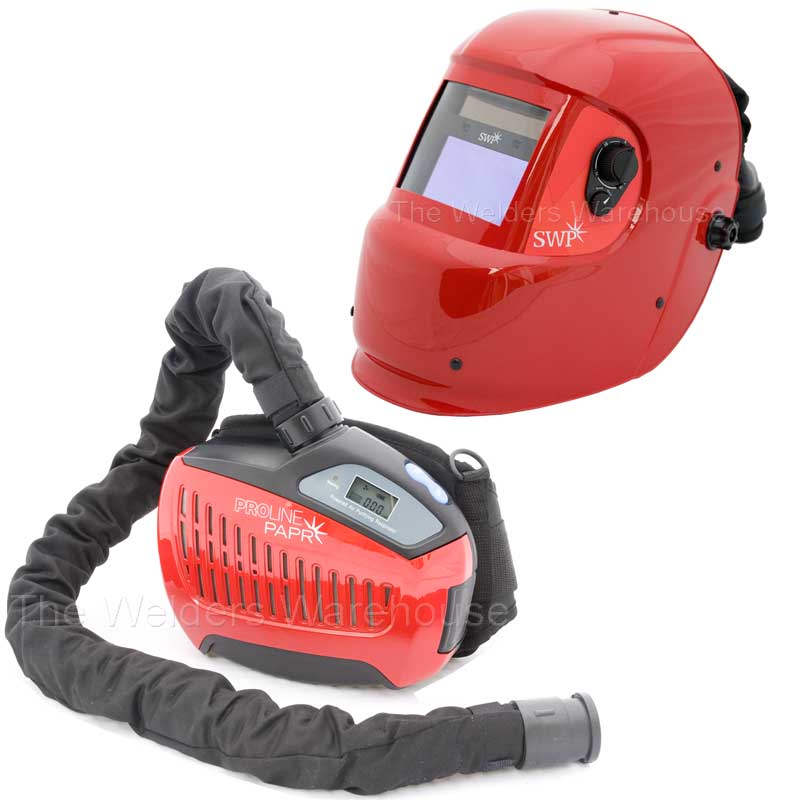
An Air Fed Welding Mask is battery Powered and worn on a belt around the welders waist. Air is sucked into the back of the Respirator Unit, through a Filter, then passed up to the Welding Helmet via a hose. This Air is then poured down across the Welders face. By creating this curtain of filtered air, which is further helped by a Face Seal, Fumes rising up from the weld do not enter the Welders Breathing Zone, inside the Welding Helmet.
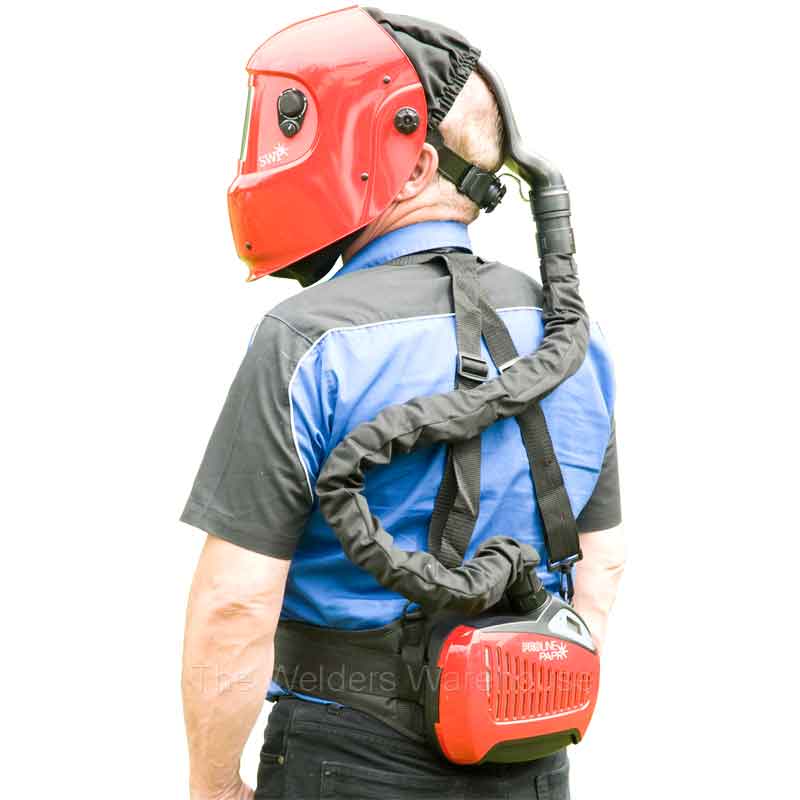
Air Fed Welding Helmet advantages include:
- Unit goes wherever the welder goes – He/She is wearing it!!
- In hot conditions, the air flow across the welders face has a cooling effect.
- An Air Fed Welding Mask is significantly cheaper than a Fume Extraction System.
Conclusion
The latest Health & Safety Executive “Safety Alert” is clear, action MUST be taken to protect Welders Lungs as well as anyone else who might be exposed to the welding fumes. Failure to do so is going to end up with much bigger problems, probably legal ones!
Please let me know what you thought of this article by leaving a comment. Don’t worry, your email address won’t be added to a database or shared and you won’t receive any unsolicited email.
Cheers
Graham


I work nights. And in the winter all doors are closed.we use esab papr respirators and weld pipes after being bent.an oils pumped into pipe when bending to keep shape.one company person from office has said they’ve changed oil and have noticed when pipes have been through causic tank it doesn’t remove all oil yet we are still expected to weld them .smoke billowing from pipe. The factory has a fog makes your throat dry and some nights feel sick. Nobody gives a s…
Hi Des
That’s terrible and will be in breach of Health & Safety!
I would anonymously contact the Health & Safety Executive and report it!
A PAPR system will only stop FUMES, fumes are a particle, burnt oil is likely to be producing gas, a PAPR will not stop gas, as your feeling sick kind of proves!!!
Don’t mess with your heath!
Cheers Graham
Hello
Theres a myth around that says these helmets can’t be shared eg if one person used the helmet and left the business then that helmet is as good as useless for anyone else to use as they could get sick from the original users breath etc. Can you debunk this myth please. Can they be shared or not?
Hi Grant
I suppose there is a theoretical risk of passing on something like head lice, but other than that I can’t really see an issue. If it was me, I would want to change the Sweatband on the head gear but as far as a previous users breath causing a problem, the air is sucked in from behind the welder, through a filter and up into the helmet. When the welder exhales, breathe would be expelled from the helmet by the fresh air being pumped in. So I don’t see any risk of getting sick.
Hope that helps
Cheers Graham
Hi there, We currently have extraction units over every welding area but would we still require Air Fed helmets as well? It is a well ventalated area anyway so we have held off for the moment, but some workers have raised concerns.
Thanks,
George
Hi George
H+S Regulations require companies to ensure that welders are not breathing in welding fumes.
This can be achieved by either removing fumes “At Source”, in other words, with Fume Extraction Equipment that prevents fumes from reaching the welders breathing zone, or the welders “Breathing Zone” has to be protected, usually via an Air Fed Welding Helmet.
So if your Fume Extractors are removing all the fume “At Source”, you should be OK. If fumes are reaching the welders “Breathing Zone”, then you should provide Air Fed Helmets.
Essentially, it’s all about making sure welders do not breath in welding fumes as these are a know carcinogen.
Our website has a useful download of a H+S “Safety Alert”
Hope I’ve helped
Graham
Can you share a helmet with your fellow workers
Hi David
A lot of welders would not want to share a helmet for hygiene reasons (real or perceived), but there’s no practical reason to not share. Bottom line, it’s Personal preference!
Cheers
Graham
Hi Graham a question if I may the company I’m working for is mixing and matching the blowers and the masks. Presumably a costing exercise. Am I right in thinking the warranty on both products are invalidated. Thank you.
Hi A Brady
Mixing blowers and masks may not invalidate warranty, that would depend on the warranty terms of each manufacturer.
What IS a problem (assuming your in the European Union), is CE compliance. When these units are manufactured the Electronic Filter in the Helmet has to be tested and CE Approved, the Helmet the Filter fits into has to be tested and CE Approved, then the WHOLE helmet unit has to be tested and CE Approved. The same applies to Blower Units and their Filters. Then, when a Blower Unit is Married with a Helmet, that WHOLE Assembly has to be Tested and CE Approved. So by mixing different makes of Blower Unit and Helmet, you DO NOT have a system CE Approved for use as Personal Protection Equipment (PPE), for Welding.
Hope this helps.
Regards
Graham